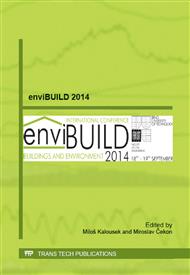p.187
p.191
p.195
p.200
p.206
p.210
p.217
p.222
p.226
Improvement of Low Inner Surface Temperature with Use of Linear Heating Component
Abstract:
Not only in Austria but also in EU and worldwide is the problem concerning restoration of old buildings very present. In the soaked massive brick walls are very often, moist caused, low thermal resistance and very low surface temperature, especially in the walls corner. At the Research Centre of Building Physics, TU Vienna, was an investigation carried out, which should act solution to this problem. To compensate thermal deficits of a cold wall corner (thermal bridge) area a linear heating component has been studied in the form of a pipe-in-pipe system, which raises the temperature of the wall corner and prevents the condensation. Through a targeted local heat supply, the necessary heating power is registered, within the temperature doesn’t fall below the critical value, at which it can come to building of condense water or to formation of mould. The calculations performed with a COMSOL program were carried out using tests on a real object. Thus, the calculated and the measured values could be compared. The first results can be seen as promising in terms of heating power saving, where you don’t need to heat the whole room to a high temperature. Through the selective heat power supply in the corner area thermal bridge effect will be eliminated.
Info:
Periodical:
Pages:
206-209
Citation:
Online since:
October 2014
Authors:
Price:
Сopyright:
© 2014 Trans Tech Publications Ltd. All Rights Reserved
Share:
Citation:


